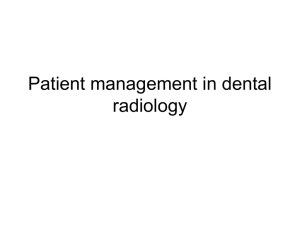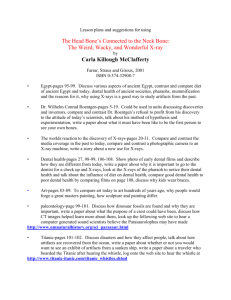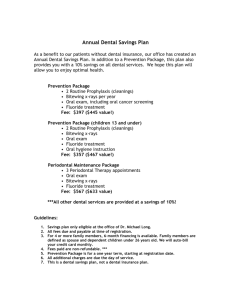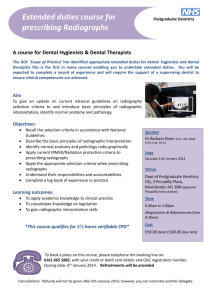Chapters 1, 11, 12, 13 and 14
advertisement
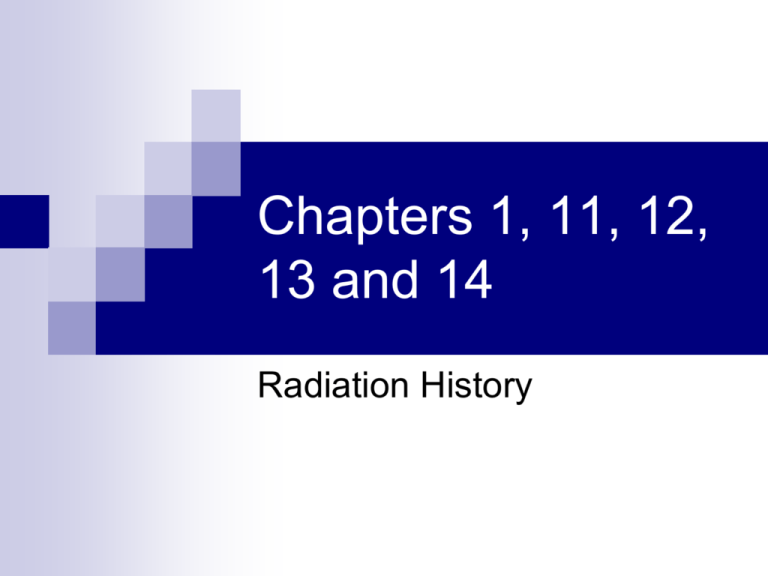
Chapters 1, 11, 12, 13 and 14 Radiation History FYI Detection is one of the most important uses of a dental radiographs. With radiographs we can detect disease and decay without clinical symptoms. History of X-rays Wilhelm Conrad Roentgen ( Ren-ken ) Bavarian Physicist Discovered x-rays November 8, 1895 Changed medical and dental field forever Practiced on his wife’s hand History Cont…. Otto Walkhoff German dentist Made first dental radiograph that was exposed for 25 mins. ( now it’s 1/10 of a sec.) History Cont… C. Edmund Kells Dentist from New Orleans First to use x-rays for dental purposes in 1896 Used his hands to place and hold films, which led to the development of cancer to his hands. He later lost his fingers, then hand and arm. He also was the first dentist to hire an assistant. The importance of Dental X-rays Diagnostic purposes Oral exams are limited Conditions can be detected in x-rays that are unseen by the eye. X-rays contain more information than a written record or chart. Past x-rays help in future diagnosis, and are always taken to benefit the patient. Benefit of Dental Radiographs Detection of disease – primary benefit Benefit of disease detection far outweighs the risk of small doses of radiation, especially with today's dosages. Minimizes pain and expense- by early detection abnormalities can be corrected before they become too involved. (prevention). Uses of Dental x-rays Many conditions do not produce symptoms, they are asymptomatic. Radiographs can detect conditions before they are felt by the patient. Information found on x-rays include: Missing teeth Extra teeth Impacted teeth Dental caries Periodontal disease Tooth abnormalities Information found cont… Retained roots Cysts and tumors Lesions Disease Routine procedures / RCT measurements Information cont….. Monitor growth and development of bone Monitor eruption and exfoliations of the teeth Trauma Who is classified as a Dental Radiographer? Any person who positions, exposes and processes dental x-ray. Dental assistant and Hygienist, sometimes the doctor. Must understand responsibility. Must have technical skills / patient management skills- patient will usually ask you question about radiation safety vs. the doctor. Who’s classified cont….. Must be licensure ( state to state ). Must gain patients trust. Duties and Responsibilities Place, expose, process and mount x-raysyou cannot diagnose. You can look at the x-rays, but you cannot tell the patient what you see even if they ask. Patient education- explain importance of x-rays. Be fast and good at taking them. Duties Cont.. Dark room maintenance- being aware of the age of the chemicals / the last time they were changed or replenished. Check the rollers and clean them as required. Maintain equipment, quality control, and inventory- running test films thru the processor, cleaning rollers and chemicals, checking radiation levels of x-ray heads. Professional Goals ALARA principle- As Low As Reasonably Achievable. Patient Protection- should be your top priority and concern. Thyroid collar- flexible lead shield placed securely around the patients neck. Lead apron- protects reproductive organs and blood forming tissues from scattered radiation. Professional Goals cont… Lead apron must be( disinfected ) sprayed of wiped down between each patient. Fast film- F- speed is the fastest. Film holding devices- ensures more precise radiographs. Exposure time- limits exposure to the patient. Goals cont.. Infection control – proper sterilization of the XCP equipment. Patient comfort- as best as possible Diagnostic Operator Protection- You Avoid primary beam- travels in a straight line Safe distance away- 6ft. Away or 90 – 135 degree angle from the primary beam. Stand perpendicular to primary beam 90 degrees. Protection cont… Docimeter Badge- also called a film badge. Warn at waist level when ever your exposing radiographs. Never wear when you are being x-rayed or outdoors. Operator Competence Continuing education Books Journals Updated Techniques Interpersonal Skills Establish trust / build a rapport Bedside manner / Chairside manner Good skills promote patient confidence As important as technical skills Listening skills Effective Communication Verbal: Choice of words is extremely important Verbal communication can create confusion and misunderstand pain, discomfort, etc.. Tone of voice is crucial, not rushed or tense, not loud or excited. Non – Verbal Body language (posture, body movement, facial, expressions) make sure your nonverbal and verbal communications are consistent. (nodding head ) Use good eye contact – displays confidence Communication cont… Nonverbal and verbal communication go hand in hand. “It’s nice to see you” then smile. Facial expressions and posture help in the believability of a conversation. Listening skills Receive and understand the message. Don’t interrupt, correct, or finish their sentences Listen between the lines Facilitation skills Facilitation means the act of making easier Reduce worry and psychological stress Build patients trust Encourage questions Answer questions Say and do First impressions Appearance (entire office) The assistants personal appearance, the front office, the operatories cleanliness and order (never eat, drink, or chew gum while working with patients) check your breath!! Greetings Be professional. Greet patients by their proper name like Mr. Brown unless you have been invited to call him George. Introduce yourself if they don’t already know you and explain to them where you are taking them and why. Chairside Manner The way a dental professional conducts themselves at the patient’s chairside. Avoid comments like oops, cursing, put downs, or other inappropriate comments, or indicates a lack of control. Always be professional, patients are here for treatment and not to become your best friend. Educate as you go – explain your position within the office as well as other staff members. Manners. Cont.. Avoid personal questions – you may open up a can of worms. Do not offer personal information – you will be working with a number of different personalities, you don’t want to become the next dear Abby in a dental office. Keep up conversation – especially when the dentist is running late. Instill credibility and confidence Attitude and Patient Relationships Position of your body – how you carry yourself, your tone of voice are all indicative of your mood Show courtesy Be aware of patient phobias Be patient with difficult patients, they are usually scared and in pain. Be honest – some procedures are uncomfortable (palatal anesthesia feels like a bee sting) Patient Education and the Dental Radiographer Patient knowledge and acceptance comes from you! Realize benefits Get them to accept the prescribed treatment Follow prevention plans Decrease their fears Increase their motivation for regular treatments Explain to the patient why dental radiographs are important, and how they are used to benefit them Methods of Patient Education Oral presentation Printed literature – in the form of brochures, newspaper, or magazine articles saved. The x-ray itself – use it as a guide to show everything that can be seen and why it is important in preventive and corrective dentistry. Legal Issues And The Dental Radiographer Laws govern equipment, ionizing radiation and the people taking radiographs. Federal and State Regulations Consumer-Patient Radiation Health and Safety Act (RHS) – (federal law) Outlines requirements for safe use of x-ray equipment Legal Issues cont… Maintenance of x-ray equipment Requires certification of the dental radiographer State laws Require inspections of dental x-ray equipment on a regular basis Licensure Requirements State laws regulate the exposure of dental radiographs Other requirements maybe: Radiology certifications, exposing film under direct supervision and following restrictions concerning types of radiographs that may legally exposed Risk Management (Prevention) Refers to the policies and procedures that should be followed by the dental radiographer to reduce the chances that a patient will file legal action against the dental radiographer or the supervising dentist. Lawsuits prevention Self determination – Patients have the legal right to make choices about the care they receive. Can give consent or refuse treatment. Disclosure The process of informing the patient about the particulars of exposing radiographs Discuss diagnosis and treatment with patient Be sure patient understands PARQ! Purpose and benefit of the x-rays Assistant will take x-rays Amount and type of x-rays to be exposed Disclosure cont…. The harm if x-rays are not taken Risks associated with x-ray exposure Alternatives Dr. and Assistant should be involved in disclosure Must have informed consent from all patients whether it is written or verbal Disclosure cont… Legal guardian for patients under 18 or in competent adult Do Not misrepresent any disclosure information Do not threaten patient into disclosure Legal Issues cont… PARQ Procedures, Alternatives, Risk, Questions Can be written in the chart as a symbol of informed consent Responsibility The Dr. is responsible for performance of the Assistant The DA is responsible for their own actions also Dentist are legally accountable or liable to supervise the performance of the dental assistants and their own actions as well Legal Issues cont… Malpractice – when the dental practitioner is negligent in the delivery of dental care Negligence – when the dental treatment or diagnosis may fall below the standard of care Standard of Care – Overall quality of care that is provided by the dental practitioner Legal Issues cont…. Statute of Limitations Time period in which to bring a lawsuit or malpractice action Begins when the patient discovers that and injury has occurred as a result of dental negligence Legal Issues cont….. Patient Records Every patient must have a dental record which includes documentation of the exposure of dental radiographs and also include: Informed consent Number and type of radiographs exposed Reason for radiographs Diagnostic information obtain from x-rays Legal Issues cont…. Entries in dental record should never be erased If an error is made it should be lined threw and dated with the initials of the person that is correcting it Confidentiality All information is confidential Non–privileged persons have no access Can not discuss treatment with another patient or staff member that is not involved in the treatment Confidentiality All information is confidential Non–privileged persons have no access Can not discuss treatment with another patient or staff member that is not involved in the treatment Ownership of X-rays / Records The Dentist is the owner Reasonable access to records must be granted to patient (copies, duplicates of xrays) Originals should always stay in the office X-rays and records are retain indefinitely Store in a safe place The End!
